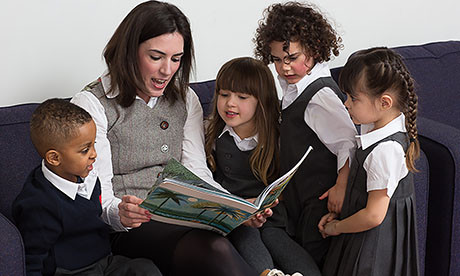Like it or not, Hackney’s free schools are forging ahead

A taste of what’s to come: Prospective students read with Hackney New Primary School headteacher Siobhan Horisk
In September 2015, Kingsland Road will welcome Hackney’s first free primary schools, helping plug the gap in the borough’s primary provision — and providing a wider platform for debate about what free schools policy means for education in Hackney.
In Haggerston to the south and Dalston to the north, two institutions will be putting into practice strikingly different visions of what a school can be.
Down by the canal in Haggerston will be Hackney New Primary School (HNPS), a venture into the 4-11 phase on the part of the Hackney New School (HNS) Trust, whose eponymous secondary opened on the same site in 2013. Nine minutes north on the 149 bus will be Halley House School, set up by the Bellevue Place Education Trust (BPET). This week Halley House went one step further toward opening its doors, announcing its funding agreement had been approved by the Department for Education (DfE).
Managerial structure is at the heart of controversies over free schools (directly accountable to the Department for Education, rather than to the local authority). On this point these two institutions differ by some margin, not least in the size of the organisations.
The HNS Trust was formed in 2012 by a group of Hackney residents unhappy with existing educational provision in the borough. The group included a financier, a concert violinist-cum-strategy consultant, and a technology company HR manager. Some of the founders will be sending their own children to HNPS.
BPET, by contrast, was set up by established provider Bellevue Education – which runs a chain of independent schools in the UK and Switzerland – and the Place Group, a school services consultancy which helps free school proposers with the business of applying for, opening and running new free schools. BPET currently operates one academy and one free school, with three more opening this year.
Claire Syms, who will be head teacher at Halley House from September, points out that this network has its benefits: “Still having that family of schools, even if they’re not in the same borough.”
Sharing practice is what BPET’s all about, aiming, as Syms puts it, to “combine what the independent sector does well with what the state sector does well.”
The HNS Trust is working to a different model: all-through education. HNPS will eventually join up with its affiliated secondary school, meaning that a child can start age 4 in Reception and leave aged 16 after GCSEs. The arrangement is intended to palliate the ‘secondary slump’, the fall-off in achievement at the start of
Big School.
“Our secondary school has pupils from 50 primary schools,” says Phillippa De’Ath, one of the HNS Trust directors. “The first term is spent working out what they
actually know.”
Halley House is opting for the standard 9am – 3.30pm school day, while HNPS’s day runs 8.45am-4pm. This extra 45 minutes equates to four fifths of an extra academic year.
For HNPS, a longer day will in part allow for timetable space for music, the school’s subject specialism. Every student will learn an instrument, with lessons provided free of charge.
Meanwhile Halley House will focus on information and communications technology.
There will be little actual competition between the two schools — Hackney badly needs primary places. But whether you find them overwhelming or liberating, the options are there.
